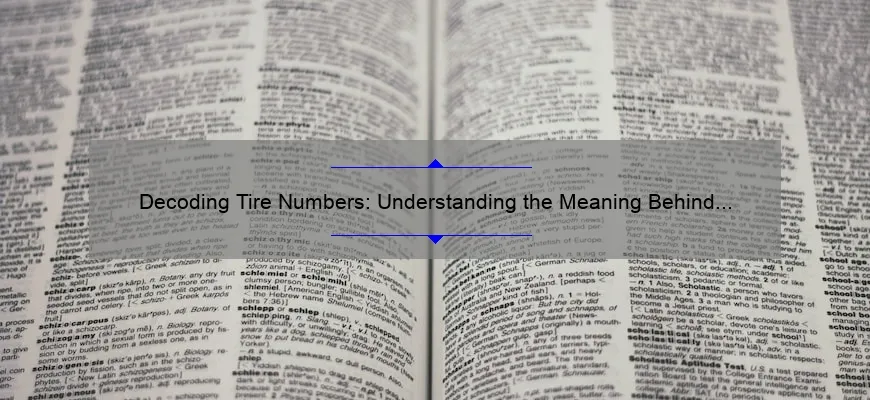Short answer: What does tire numbers mean?
Tire numbers refer to the combination of letters and/or numbers on a tire’s sidewall that denote the tire’s size, load capacity, speed rating, and other important characteristics. The numbers indicate the width of the tire in millimeters, aspect ratio (height to width), diameter of the wheel it fits into and its load index or carrying capacity whereas alphabets signify its construction type such as radial or bias ply.
Step by Step Explanation: What Does Tire Numbers Mean and Their Significance?
Have you ever looked at the sidewall of your tire and wondered what all those numbers mean? It can be overwhelming to see a combination of letters, numbers, and symbols on something as seemingly simple as a tire. But fear not! Tire numbers actually provide important information about your tires’ size, performance capabilities, and more.
Let’s break down the different parts of tire numbers:
1. Tire Size: This is typically displayed in a format such as P225/65R17 or 265/70R16. The first letter (P) signifies that it’s a passenger car tire, while the following three-digit number (225 or 265) indicates the width of the tire in millimeters. The second set of digits (65 or 70) represents aspect ratio – essentially how tall the sidewall is compared to its width. Finally, R stands for radial construction and the last two digits indicate rim diameter (in inches).
2. Load Index & Speed Rating: These are designated by two- or three-digit codes located after the tire size and indicate how much weight the tire can support (load index) and how fast it can safely go (speed rating). For example, an 89V load index/speed rating means that each tire can support up to 1,279 pounds and travel safely at speeds up to 149 miles per hour.
3. Traction & Temperature Grades: These grades represent a measurement scale used by manufacturers to rate tires’ ability to grip wet roads (traction grade) and resistance to heat buildup during high-speed use with an A-F grading system.
So why does knowing these measurements matter? Well first off when buying new tires they need to match exactly with what is specified for your make/model/year vehicle so that handling will be safe especially out on our highways where there may already be hazards one needs their full attention on navigating well through situations quickly if necessary etc rather than having additional problems added by mismatched equipment This can also help improve your car’s handling and overall safety on the road.
Additionally, larger wheels and tires may look cool but they also have a real impact on performance. They can affect acceleration, braking distance, fuel economy, ride comfort, and alignment (among other things). Knowing the proper tire size and load capacity ensures that you’re getting optimal performance from your vehicle while minimizing unnecessary risk during daily driving or longer trips.
Finally when shopping for new tyres understanding these numbers in relation to what works best based off how you use your automobile will create more value return since they are four components of such importance when it comes down not just creating looks but enhancing driving characteristics too! Investing wisely in quality tire maintenance/upgrades makes all difference as to whether or not we truly enjoy our cars out there anywhere roads take us next with freedom liberty bliss met in action.
FAQ About What Does Tire Numbers Mean- Answers to Your Queries!
Tire numbers may seem like a set of random digits, but they actually hold important information about your vehicle’s tires. Understanding these numbers is crucial in determining the right tire for your car and ensuring its safe operation on the road.
To help you out, we’ve compiled some frequently asked questions regarding tire numbers and their meanings.
Q: What do the letters and numbers mean on my tire?
A: The combination of letters and numbers found on your tire is known as the Tire Identification Number (TIN). It provides information about the manufacturer, size, construction type and model year of the tire. For example, P225/70R16 102H indicates that it is a Passenger Car radial (P) tire with a width of 225 millimeters, aspect ratio (profile) of 70%, designed to fit on a wheel diameter of 16 inches at maximum inflation pressure specified by DOT. The ‘H’ denotes speed rating – up to maximum speed limit certified by DOT
Q: How can I determine what size tires will fit my vehicle?
A: Your car’s owner manual or inside door jamb has recommended sizes given from manufacturer depending upon engine/powertrain setup opted while purchasing. You should stick to those sizes unless there are any modifications done in suspension / brakes areas which need higher rated tires than standard optioned ones
Q: What does “aspect ratio” mean?
A: Aspect Ratio or profile refers to height fo sidewall measured as percentage against section width . A smaller number means lower/wider profiling giving sporty flatter look while larger values (more than base numeric value e.g. if based off 70 then >75 ) indicate more stance increasing cushioning/suspension ride comfort/demands.
Q : Can I mix different brands or types of tires on my vehicle?
A : Ideally not recommended since each brand/product line uses different rubber compound/ carcass technology/modulation leading to uneven wear, lower support in emergencies then rated for. Coz that lowers the life of both pairs and adds to potential blow off risks from road hazards.
Q: How often should I replace my tires?
A : Normal running with rotation may net you around 40to60K Miles before it wore out except when punctured due to cuts/gashes/car damage etc.. Any abnormal noise/vibration while driving can indicate need of tyre service inspection by duly authorised personnel
In conclusion, understanding tire numbers is crucial for the safety and longevity of your vehicle’s tires. Make sure to refer these questions whenever there arises any doubts or confusions regarding tire identification or replacements .
Top 5 Fun Facts About What Does Tire Numbers Mean That You Should Know
Tire numbers are often overlooked by car owners, but they are crucial to understanding the performance and safety of your vehicle. These seemingly random combinations of letters, numbers, and symbols actually convey a lot of information about your tires. In this blog post, we’ll share with you the top 5 fun facts about what tire numbers mean.
1) Tire Width
The first number in a tire’s size code is its width in millimeters or inches (depending on where it was manufactured). This number indicates how wide the tire is from sidewall to sidewall when mounted on a specified rim size. For example, if you see “225” printed on your tire’s side wall, that means your tire has a width of 225mm.
2) Aspect Ratio
Following the tire’s width measurement is an aspect ratio value expressed as a percentage that represents the height of its sidewall relative to its width. A lower profile because would generally enhance handling capabilities for high-speed stability; however tires with higher profiles can handle bumps & potholes effectively due to more flexibility offered by tall walls beneath tread areas which helps withstand impacts
3) Rim Diameter
After assessing measurements of section widths and ratios comes diameter or wheel fitment representation depicted alongside aspect ratio figures – again stated either in metric dimensions like ‘R17’(inches), indicating an optimal wheel radius fitting perfectly inside such arrangement around amply sized wheels considering bead seat design compatibility based on load limitations recommended in place respectively according standards set forth during manufacturing process etc (*ISO)
4) Load Index
Load index rating basically depicts weight-carrying capacity assigned per individual tyre against every specific measurement combination described before among other specifications time be used bearing responsibility classifying load bearings safely assist drivers especially able recognize hazards ahead allowing them gain greater control over vehicle while moving through various terrain types road conditions varying dramatically across regions country provided markets worldwide suited different vehicles requirements expectations drivers looking best quality tyres avail guaranteed safety features concerned possible incompatibility issues arise between tyre types among consumers some older models as well newer ones manufactured since latest revisions industry standards which better reflect new developments experience.
5) Speed Rating
Finally, the speed rating on a tire indicates its maximum safe speed when properly inflated and within the recommended load range. The higher the speed rating, the greater the performance capabilities of that particular tire design if you plan to drive hassle-free at high speeds without compromising your vehicle’s longevity and health. Ratings can vary significantly based on manufacturing origin or specific tires produced by manufacturers across various automotive segments either for passenger vehicles,sporty rides,SUVs,crossovers etc encompassing sizes both large small conveniently available worldwide provided motorists with ample choices catering to preferences budgetary constraints while staying involved dynamic market offering best value their purchase enhancing not only performance yet fuel economy aspects key factors impacting driving habits urban rural areas alike.
In conclusion – Tire numbers might seem overwhelming at first glance, but they hold valuable insights into your safety and driving experience. By understanding what each number signifies like width, aspect ratio”, diameter (wheel fitment), Load Index &speed ratings every driver will then be able make informed decision based upon sound knowledge ensure smoother ride all times!








